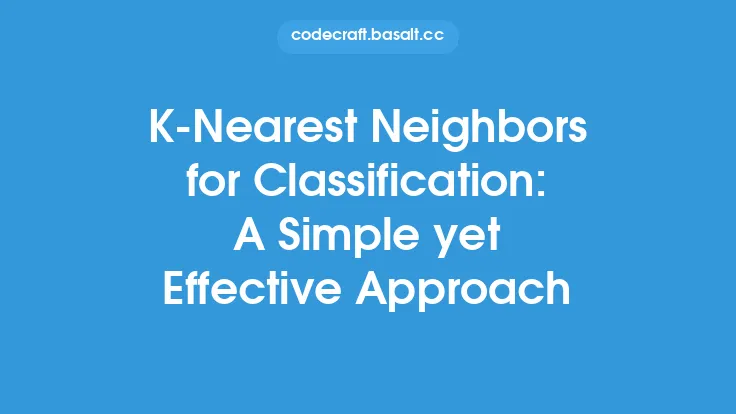K-Means clustering is a widely used unsupervised machine learning algorithm that partitions the data into K clusters based on their similarities. The algorithm works by iteratively updating the centroids of the clusters and reassigning the data points to the closest cluster until convergence. This technique is simple, efficient, and effective, making it a fundamental approach in clustering analysis.
Introduction to K-Means Algorithm
The K-Means algorithm is a non-hierarchical clustering technique that requires the number of clusters (K) to be specified beforehand. The algorithm starts by randomly initializing the centroids of the K clusters. Then, it assigns each data point to the closest cluster based on the Euclidean distance between the data point and the centroid. The centroid of each cluster is then updated to be the mean of all data points assigned to that cluster. This process is repeated until the centroids no longer change or a stopping criterion is met.
Key Components of K-Means Clustering
There are several key components of the K-Means clustering algorithm. The first is the choice of the number of clusters (K). This is a critical parameter that needs to be specified beforehand. The second is the initialization of the centroids. The algorithm is sensitive to the initial placement of the centroids, and different initializations can lead to different results. The third is the distance metric used to measure the similarity between data points and centroids. The most common distance metric used is the Euclidean distance, but other metrics such as Manhattan distance or Minkowski distance can also be used.
How K-Means Clustering Works
The K-Means clustering algorithm works as follows:
- Initialize the centroids of the K clusters randomly.
- Assign each data point to the closest cluster based on the Euclidean distance between the data point and the centroid.
- Update the centroid of each cluster to be the mean of all data points assigned to that cluster.
- Repeat steps 2 and 3 until the centroids no longer change or a stopping criterion is met.
- Assign each data point to the closest cluster based on the final centroids.
Advantages and Disadvantages of K-Means Clustering
K-Means clustering has several advantages. It is simple, efficient, and effective. It can handle large datasets and is relatively fast compared to other clustering algorithms. However, it also has several disadvantages. It requires the number of clusters (K) to be specified beforehand, which can be difficult to determine. It is sensitive to the initial placement of the centroids and can get stuck in local optima. It assumes that the clusters are spherical and well-separated, which may not always be the case.
Choosing the Right Number of Clusters
Choosing the right number of clusters (K) is a critical step in K-Means clustering. There are several methods that can be used to determine the optimal number of clusters, including the Elbow method, Silhouette method, and Gap statistic method. The Elbow method involves plotting the sum of squared errors (SSE) against the number of clusters and choosing the point where the rate of decrease of SSE becomes less steep. The Silhouette method involves calculating the silhouette coefficient for each data point and choosing the number of clusters that maximizes the average silhouette coefficient. The Gap statistic method involves calculating the gap statistic for each number of clusters and choosing the number of clusters that maximizes the gap statistic.
Handling Outliers and Noisy Data
K-Means clustering is sensitive to outliers and noisy data. Outliers can affect the centroids of the clusters and lead to poor clustering results. Noisy data can also affect the clustering results and lead to over-clustering or under-clustering. There are several methods that can be used to handle outliers and noisy data, including data preprocessing, robust clustering algorithms, and outlier detection methods. Data preprocessing involves removing outliers and noisy data before applying the clustering algorithm. Robust clustering algorithms involve using algorithms that are resistant to outliers and noisy data. Outlier detection methods involve detecting and removing outliers before applying the clustering algorithm.
Variations of K-Means Clustering
There are several variations of K-Means clustering, including K-Medoids, K-Modes, and Fuzzy K-Means. K-Medoids is a variation of K-Means that uses medoids instead of centroids. Medoids are objects that are representative of their clusters. K-Modes is a variation of K-Means that uses modes instead of centroids. Modes are the most frequent values in a cluster. Fuzzy K-Means is a variation of K-Means that allows data points to belong to multiple clusters with different membership degrees.
Real-World Applications of K-Means Clustering
K-Means clustering has several real-world applications, including customer segmentation, image segmentation, gene expression analysis, and recommender systems. Customer segmentation involves clustering customers based on their demographics, behavior, and preferences. Image segmentation involves clustering pixels in an image based on their color, texture, and intensity. Gene expression analysis involves clustering genes based on their expression levels. Recommender systems involve clustering users based on their preferences and recommending products or services to them.
Conclusion
K-Means clustering is a fundamental approach in clustering analysis. It is simple, efficient, and effective, making it a widely used algorithm in machine learning. However, it requires the number of clusters (K) to be specified beforehand and is sensitive to the initial placement of the centroids. It assumes that the clusters are spherical and well-separated, which may not always be the case. Despite these limitations, K-Means clustering has several real-world applications and is a useful tool in data analysis and machine learning.





